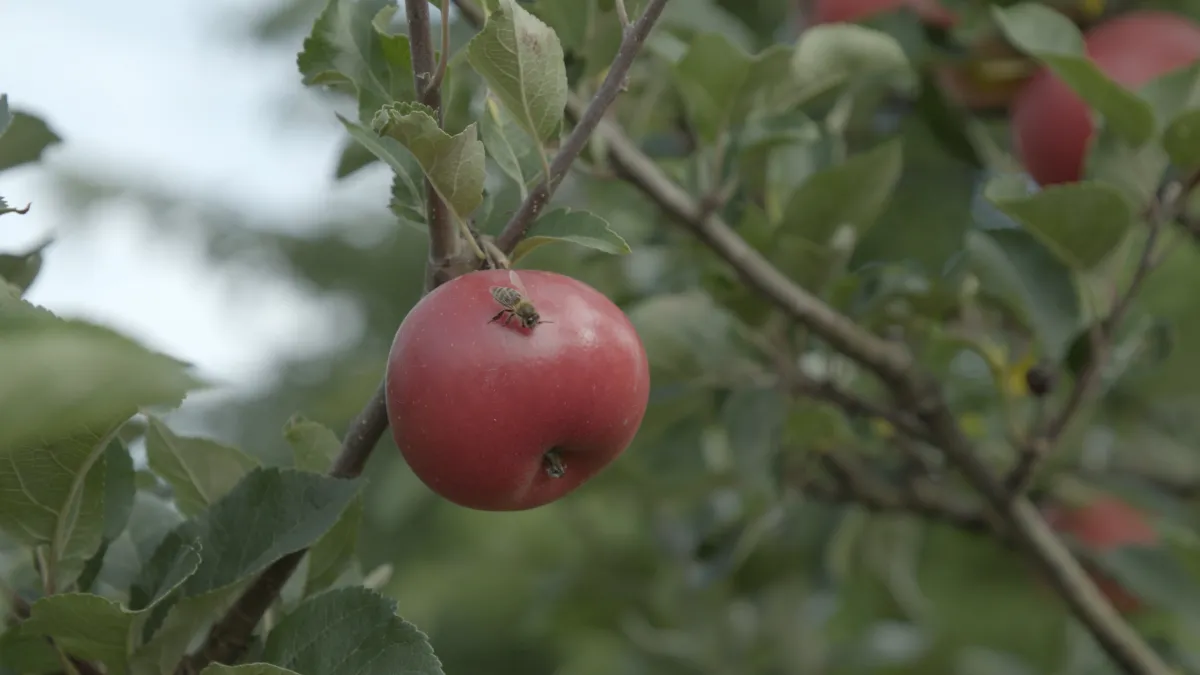
-
Nefise Özkal Lorentzen, Director/Producer
-
Jørgen Lorentzen, Producer
-
Ola K. Hunnes, Producer

About the Project
Logline:
“This Is Not an Apple” follows three Palestinian siblings in Oslo who, after surviving a brutal stabbing, seek redemption and face their pasts through an apple farming project that unexpectedly connects them with high-security prison inmates.
Synopsis
“This Is Not an Apple” tracks the lives of Palestinian siblings Reda, Yahya, and their sister Maria, living in Stovner, a suburb of Oslo notorious for gang-related activity. The brothers’ sense of safety and trust is shattered after they are seriously wounded in a stabbing, an act of betrayal by their former friends. Struggling with a mix of hurt and a yearning for revenge, they find their mother’s calls for forgiveness a tough pill to swallow.
The siblings’ path to recovery leads them to "Líf Laga," an apple farming project in their own community. Here, under Åsmund’s guidance, they join other young locals facing their own challenges. Together, they learn more than just agriculture—they learn about resilience as they share their experiences of life’s hardships.
"Líf Laga" then takes a bold step, reaching into one of Norway’s high-security prisons, Ullersmo Prison. Reda and Yahya are part of this expansion, teaching apple farming to inmates. In the prison garden, they meet young men who reflect their own troubled pasts. These interactions make the brothers question their feelings about vengeance and justice.
As they exchange stories with the inmates, Reda, Yahya, and the rest of the youth from "Líf Laga" confront the thin lines that separate their lives from those serving time. For the inmates, meeting youths who are free yet share similar stories offers a glimpse into a world they’ve left behind, sparking aspirations for a second chance.
The film presents a stark look at how paths can diverge and how close anyone can come to a life they never expected. It explores the struggles we share, the hard work of forgiving, and the surprising ways we can help each other heal. Will the siblings be able to forgive their attackers? Can Reda achieve his dream of getting accepted into medical school? How will Yahya cope with his post-traumatic stress? "This Is Not an Apple" asks these questions and more, inviting the audience to reflect on the power of growth, both in the orchard and in the heart.
Director’s Note
The initial idea was to make a film about Líf Laga, an environmental depiction. While filming, I noticed something special about Reda and Yahya, who worked alongside a young girl in the apple orchard. I did not know that this girl was their sister, Maria. During a lunch break, all three talked about a lawsuit. They told me about the stabbing, the pain. They said they want to be role models for youth. That was when I realized that this film must be about more than just apples. It should be about the youth, and the siblings' journey to healing and forgiveness.
As a filmmaker with a Turkish-Norwegian heritage, I stand at the intersection of two cultures, experiencing both inclusion and exclusion. This duality fuels my empathy and understanding of the themes explored in "This Is Not An Apple," which focuses on human values, community healing, and shared experiences.
For three decades, my work has centered on international themes, human rights, and national conflicts. I have traveled the world, tackling urgent and often controversial subjects. These films have always been relatively easy to present due to their critical nature. However, "This Is Not An Apple" represents a significant shift in my approach. It delves into the soft yet powerful values embodied in apple farming, which offers a sense of belonging and purpose to the youth.
In April 2024, the youth of Líf Laga planted 100 apple trees at the high-security prison Ullersmo. I saw how they collaborated with the inmates. After the work, the youth asked each other about the thin line between being free and being behind the walls. They all have connections to the prison in their lifetimes. Our camera lenses captured the bewilderment and empowerment among both the Líf Laga youth and the inmates. It was the first time in Norway that immigrant youth planted apple trees in a prison and taught the inmates how to harvest them. I must admit, I had tears in my eyes.
This is not a tale of loss, but of rebuilding. A depiction of how even the deepest wounds can heal, how even the most brutal events can lead to growth, and how the hand that once held a knife can now nurture and care.
This project has made me question and broaden my understanding of human values. Can an apple orchard address the problems of urbanization, youth gangs, criminality, and radicalization? Yes. It is a unique setting that fosters both consciousness and a sense of belonging. Through this project, I am also addressing my own feelings of displacement and the anger stemming from the skeptical gaze of the majority towards minorities. The apple project has shown me the strength of soft values. I hope to convey this strength to the audience.
Visual style and form
Our approach has primarily been observational. When situations arose where the subjects themselves wanted to explore certain elements of their story, we facilitated this, being careful not to create events that could disturb the film's authenticity. This film is not based on interviews. Instead, we follow the characters in their dialogues with each other, to capture the natural power of dialogue.